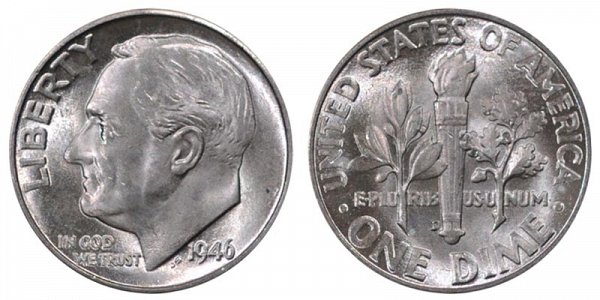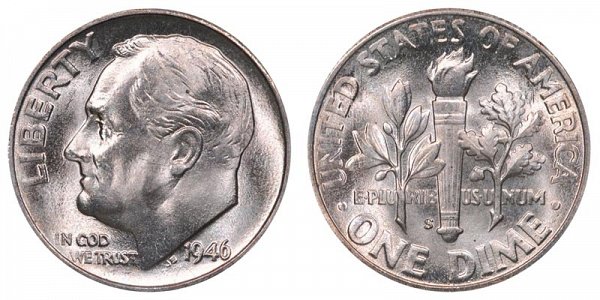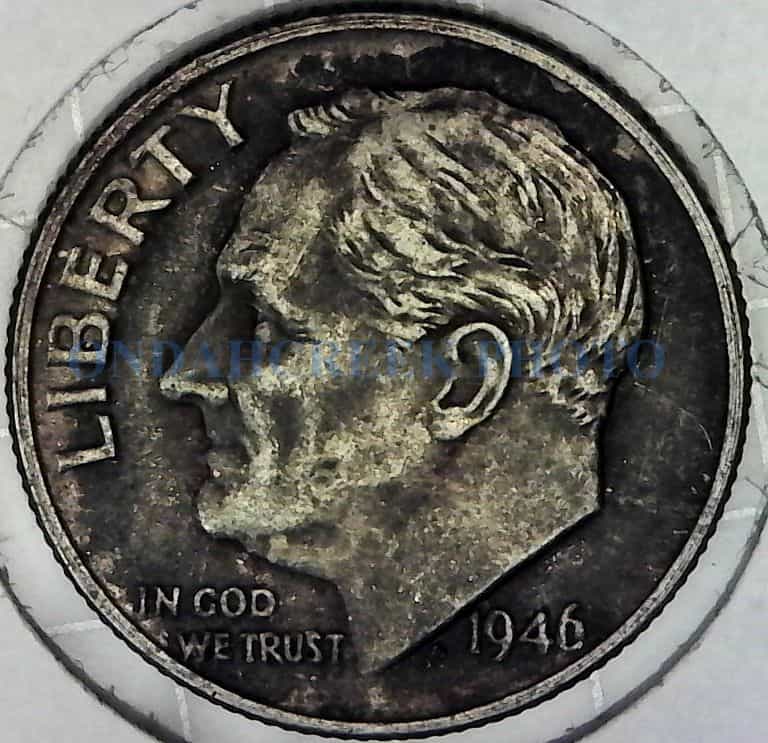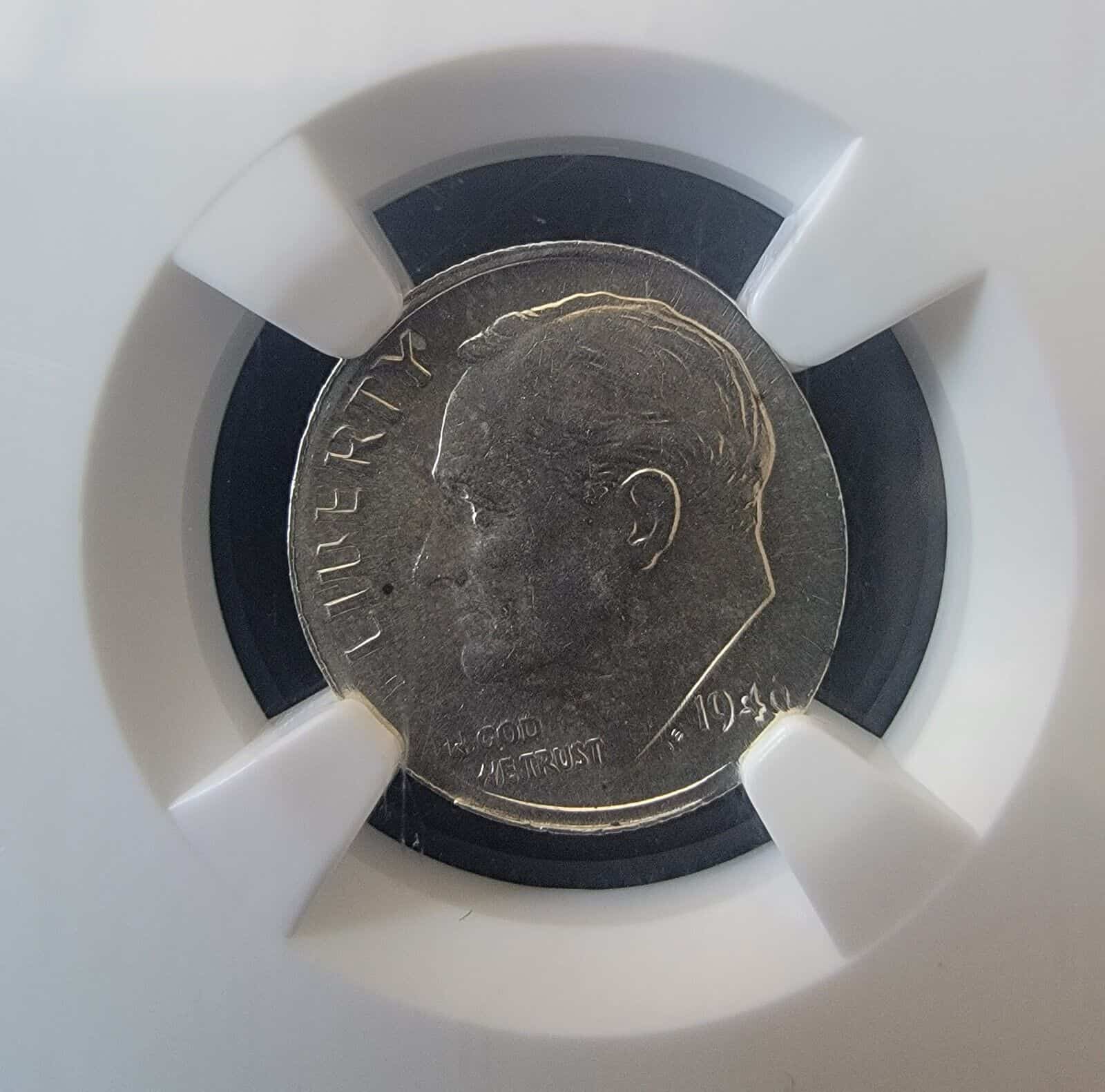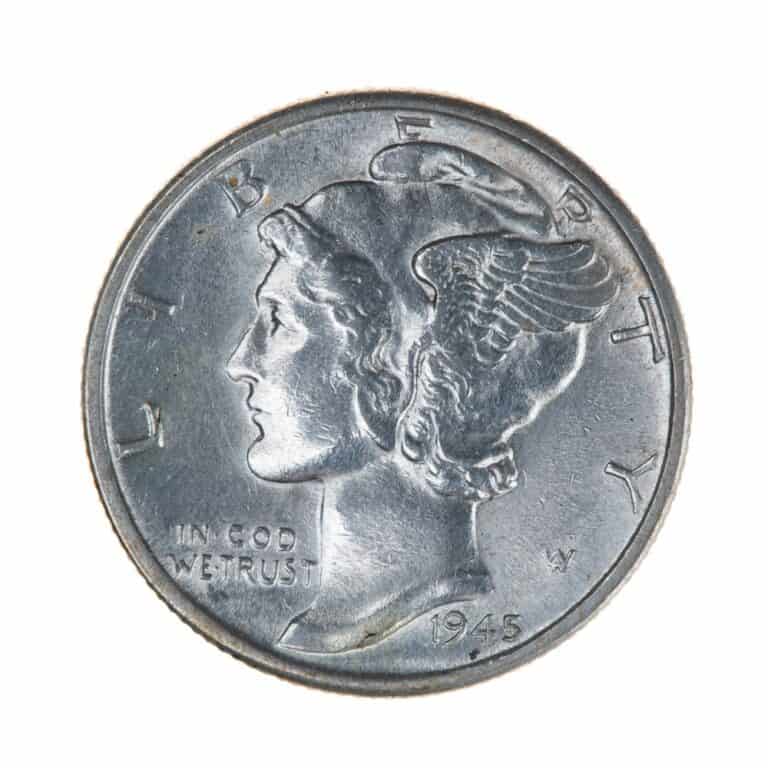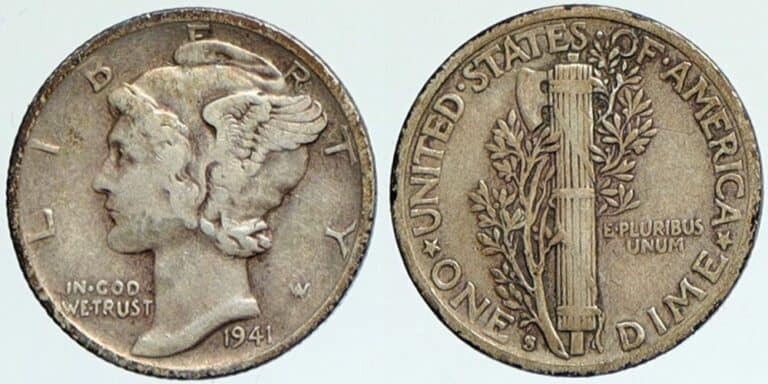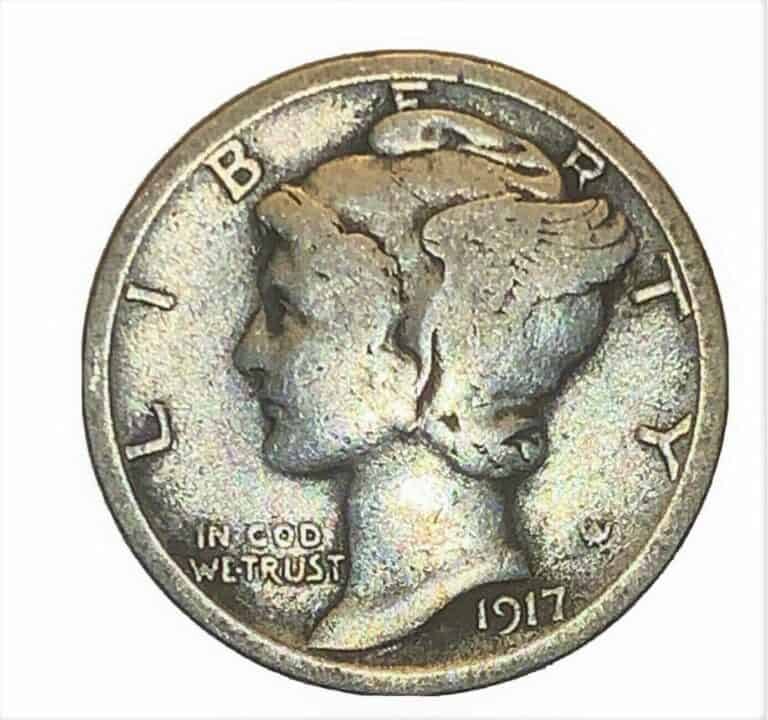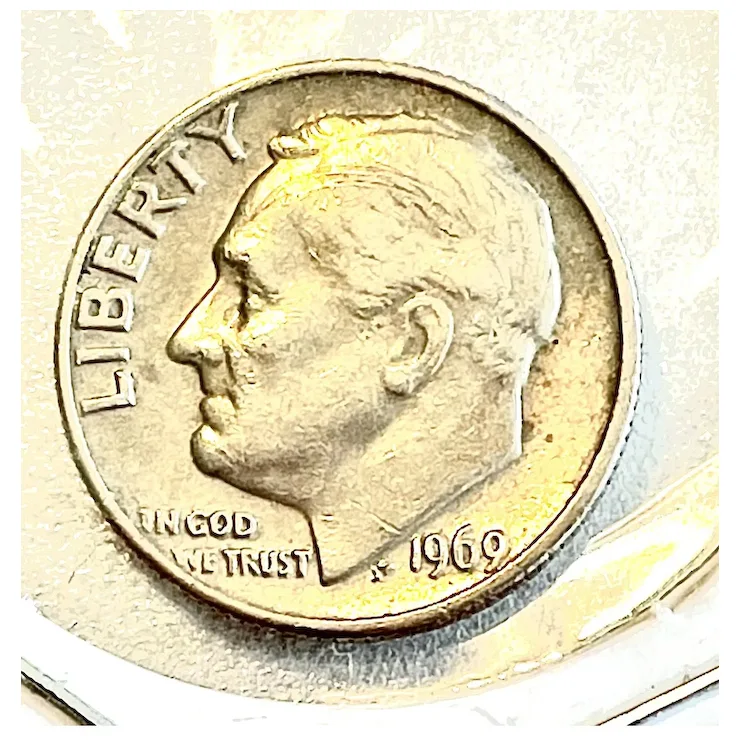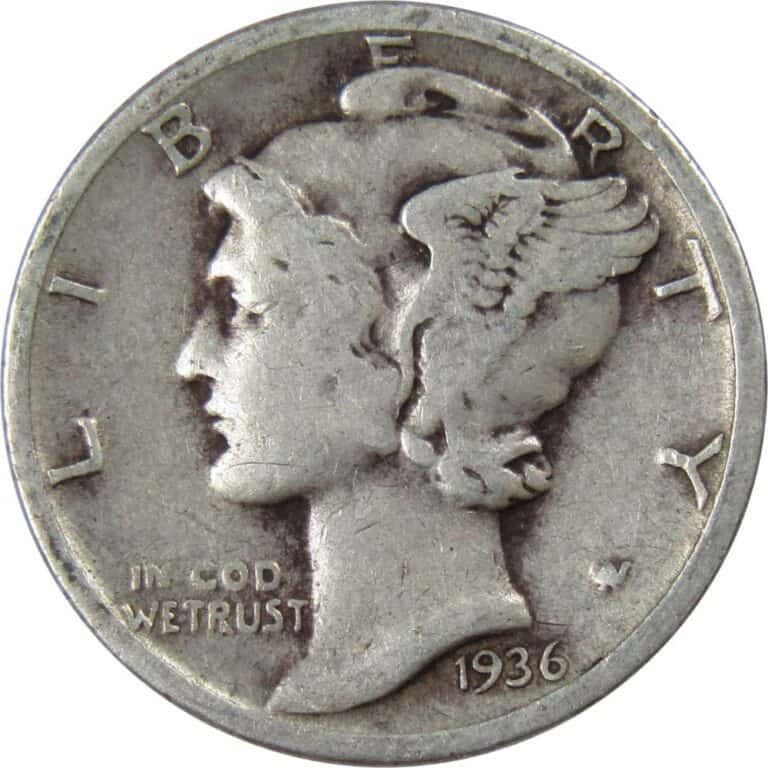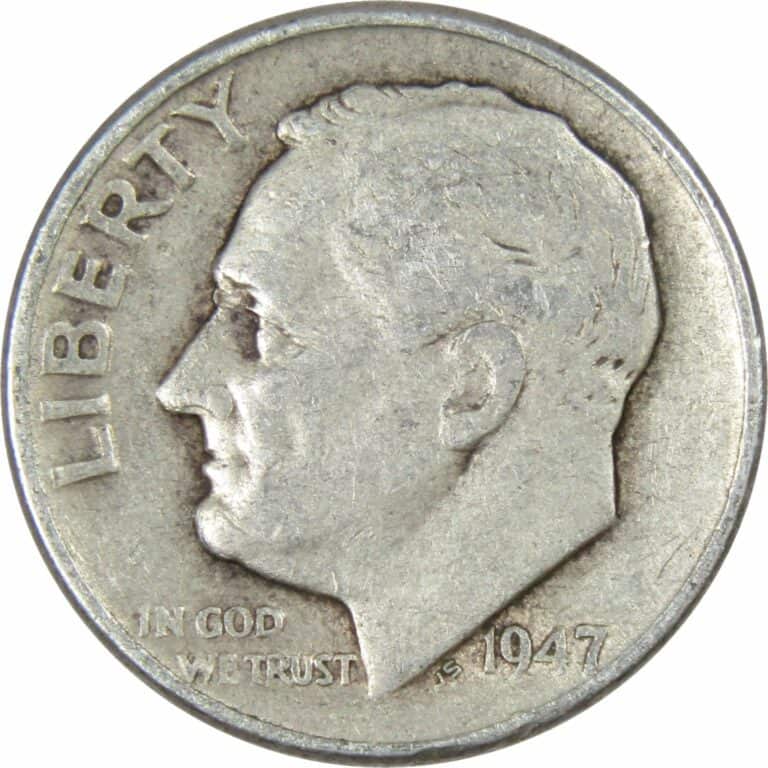1946 Dime Value: How Much Is It Worth Today?
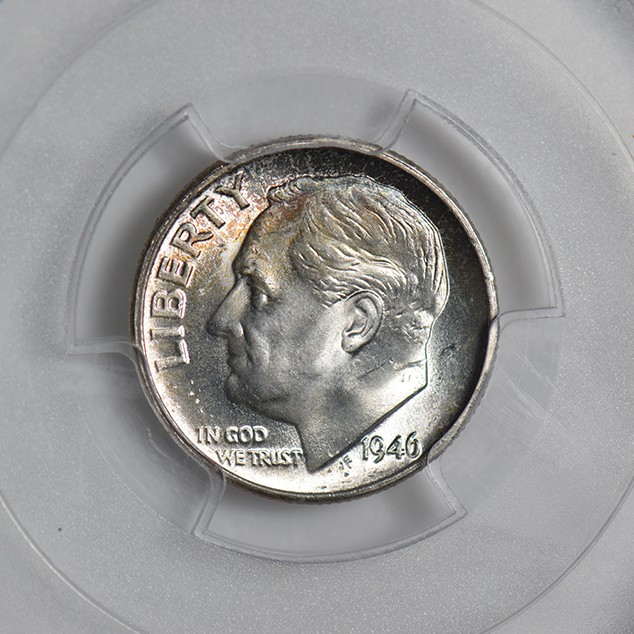
Any dime collection is incomplete without the valuable 1946 dime to mark the start of the Roosevelt dime series. These coins carry a premium price due to their silver content, but they’re often worth more due to historical significance and conditions.
While the silver melt value varies depending on the daily price on silver, most 1946 dimes are worth at least $2.14 to $5.80. When the coins go to auction they regularly sell for $50 to $150, although a few breakout examples brought in thousands.
This article expands on the different types of 1946 dimes and valuable errors you may come across, as well as the significance of the 1946 dime as the first of its series. We also touch on how you can assess the value of your coin without recruiting professional help.
1946 Dime Value Chart |
||||
| Mint Mark | Good | Fine | Extremely Fine | Uncirculated |
| 1946 No Mint Mark Dime Value | $2.03 | $2.14 | $2.26 | $5.80 |
| 1946 D Dime Value | $2.03 | $2.14 | $2.26 | $5.80 |
| 1946 S Dime Value | $2.03 | $2.14 | $2.26 | $5.80 |
The 1946 dime was the first of the Roosevelt series that continues today. As such, it’s a highlighted year for many collections.
The obverse design features a portrait of the late 32nd President Franklin Delano Roosevelt. His profile faces the left of the coin, and the required LIBERTY inscription is printed on that side of the coin. Below Roosevelt’s chin is IN GOD WE TRUST, along with the designer initials JS underneath the neck.
The reverse design, also from Chief Mint Engraver John Ray Sinnock, features an olive branch (for peace), a flaming torch (for liberty), and an oak branch (for strength). The E PLURIBUS UNUM motto is printed among the three symbols.
Other reverse inscriptions include the mint mark to the left of the torch, UNITED STATES OF AMERICA on the top rim, and ONE DIME on the lower rim.
The 1946 dime is 90 percent silver and 10 percent copper with a silver content of 0.0723 oz. The round coin is the smallest and slimmest of all in circulation with a diameter of 17.81 and a 1.35 mm thick reeded edge.
Today’s dimes weigh less than the 1946 dime’s 2.5 grams. These coins were originally intended to offer 1/10th the value of a silver dollar (hence the name inspired from the French disme, meaning “tenth” or “tithe”), and they needed to be appropriately sized to ensure the melt didn’t surpass the face value.
There were a total of 314,193,500 dimes minted in 1946 with no proof coins produced.
1946 No Mint Mark Dime Value
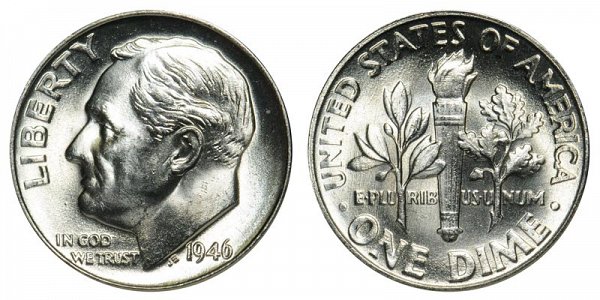
Philadelphia produced the highest number of dimes of the three mints in 1946 with 225,250,000 put into circulation. Overall, this was the sixth highest mintage of the silver years.
It’s not unusual for the mint to make more coins in the initial year of a new series. Collectors are bound to snatch them up, and the greater number helps replace the coins knocked out of circulation in the previous series.
The abundant population means that well-worn 1946 no mint mark dimes are only worth their silver. This increases marginally to $2.14 in “Fine” condition, $2.26 in “Extremely Fine” condition, and $5.80 when “Uncirculated”.
The record holding for a 1946 no mint mark dime at auction is a near-perfect NGC-graded MS69. The coin sold for $12,650 at a 2004 auction.
Recent auction records are more modest, and we instead see a highly graded coin selling in the $50 to $150 range.
The Controversy of the Roosevelt Design
While the use of Roosevelt for the face of the dime isn’t an issue, the coin is not without its controversy.
Immediately after the coins rolled off the mint the public raised concerns about designer John Sinnock’s initials on the reverse. Post World War II tension had a number worried that the “JS” was a secret Soviet symbol for Joseph Stalin.
Another issue that’s risen over time is over the correct attribution of the design. While the Mint has denied this claim, mint records show that Sinnock’s eventual successor Gilroy Roberts may have done most of the work on the design.
The design also bears a close resemblance to that of Selma Burke, an renowned sculptor who won a contest to sculpt President Roosevelt’s likeness in 1943. Burke actually sat with the president for a live sketch.
Roosevelt died five months before Burke’s plaque was revealed, and the new dime design was unveiled shortly after. While Sinnock noted that he referenced old photographs and a few relief sculptures, he did not credit Burke in any way. Instead, Sinnock denied any accusations of taking undue credit for her design.
Regardless of designer controversy, the 1946 design put forth a striking and memorable piece of American coinage that the country has yet to replace.
1946 D Dime Value
The Denver mint also produced one of its largest runs of the Roosevelt dime series, and it put 61,043,500 1946 dimes into circulation.
Despite producing less than ⅓ of what Philadelphia put out, a 1946 D dime is worth the same as the unmarked coins depending on grade. These coins remain plentiful despite decades of circulation, and they’re easy enough for collectors to find.
Auctions see the coin sell for a greater average than the no mint mark variety. The record belongs to a NGC MS68* 1946 D dime that sold for $4,888 in 2007, but recent auctions let the coin go for $120 to $200.
1946 S Dime Value
Despite the miniscule production of only 27,900,000 new 1946 S dimes, the San Francisco coins aren’t worth anything greater than those from other mintages. The smaller quantity increases the premium put on popular errors like a repunched mint mark, but there’s little discrepancy otherwise.
The auction record holder for the 1946 S dime also sold in 2007, but for a higher PCGS MS68 grade and for $5,819. Recent auctions also sell the S-mark for more than the other two varieties, averaging closer to $200+.
1946 Dime Grading
Grading with the naked eye will not replace professional grading on a 70 point scale, but it’s an economical method of assessment and a good skill to have. When looking at a 1946 dime, we recommend you have a decent understanding of what the coin is supposed to look like in Mint State.
When you understand the intended design it’s easier to determine how worn down a coin is. A 1946 dime in mint state has virtually no wear to the surface, and even minor marks can take hundreds off the eventual value of the coin.
Focus your attention on high points and detailed areas, such as the hair and small lines above the ear. These points should retain their luster and original texture.
A 1946 dime falls to a lower grade depending on how much wear it bears. Ideally, even worn coins should have distinguished major details (no merging of design elements) and a shine similar to its original appearance.
The Roosevelt Dime and Full Bands Designation
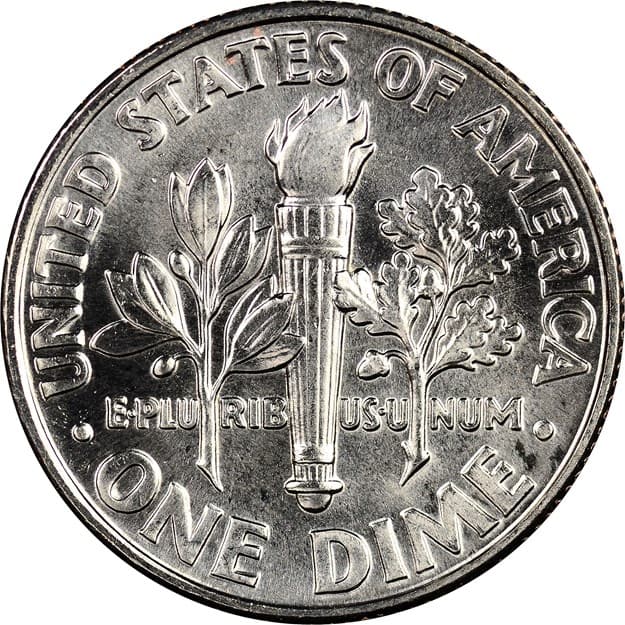
You may see an “FB” attached to the professional grade of a 1946 dime. Professional services use this to indicate the coin achieved its fully intended details, despite the fact that most failed to do so.
The “FB” refers to full bands on the reverse torch design. The original design had twin bands wrapped around the torch, but most coin strikes fail to display this detail. Full bands put a premium on the original value of the coin, especially when comparing two of a similar high grade.
Rare 1946 Dime Errors
The 1946 dime isn’t just stamped and sent on its way. The coining process involves several parts and steps, and it’s possible for an error to occur somewhere down the line.
A rare error can make a coin more valuable, but only if it’s verified to occur during the minting process. These errors usually mark a few coins, and the most common examples of the 1946 dime include:
- Repunched mint marks
- Double die errors
- Broadstruck coins
- Coins struck on elliptical planchets
Errors have a minor effect on the ultimate value of the coin. It’s more profitable to sell a coin with a high grade than a worn down error coin, but a MS coin with a Mint Error will bring in the most overall.
1946 Repunched Mint Mark Dime (D/D or S/S)
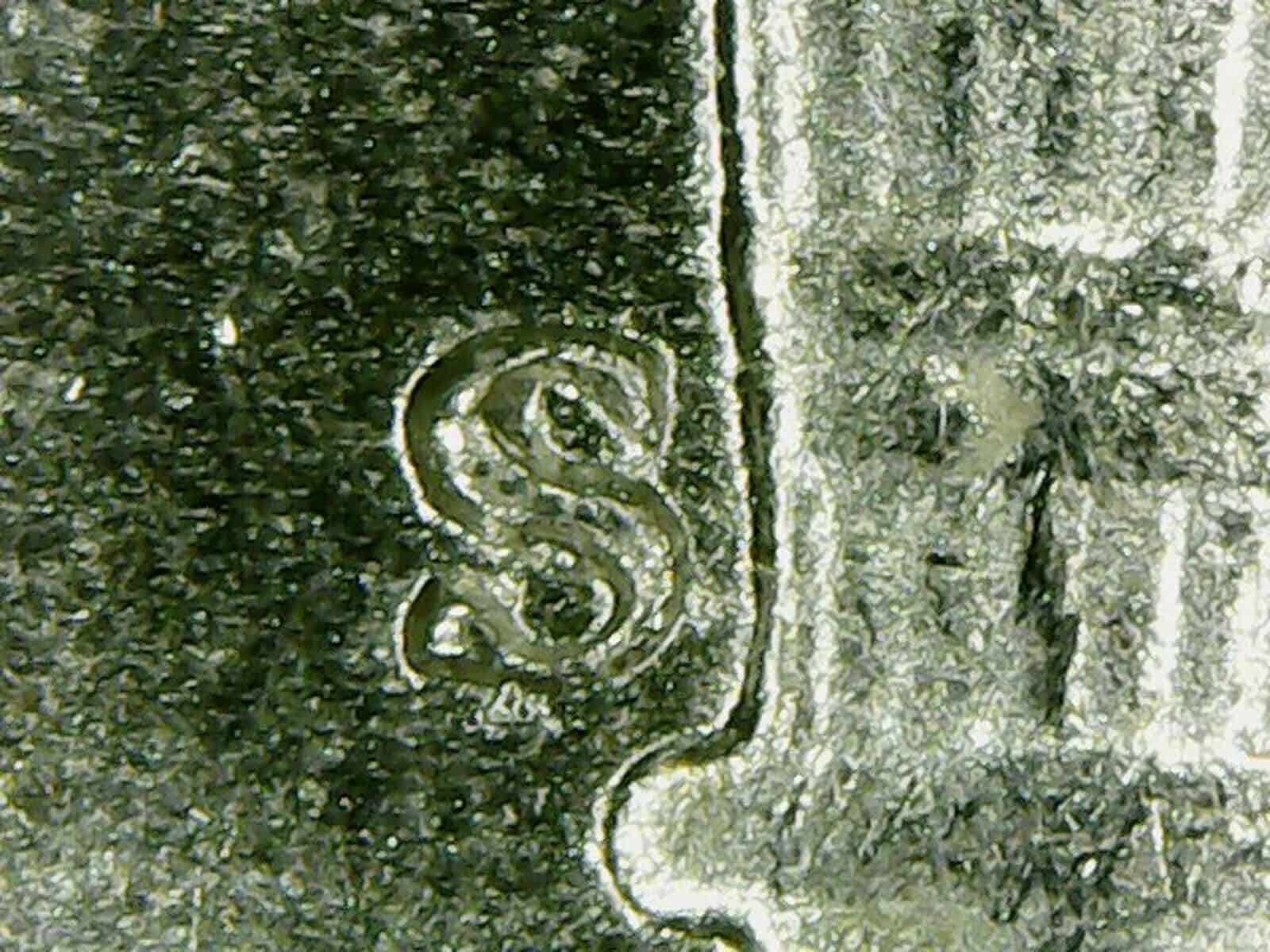
Mint marks were hand struck in 1946, leaving plenty of room for human error. When the worker struck the coin at the wrong orientation or in the wrong location, they would usually just strike the coin again (hoping for greater accuracy).
Minor repunching errors still bring in about $50 to $150, but these coins are seen at auction fairly regularly. A 1946 D dime with a D/D error graded NGC MS67FB brought in $995 from an ebay auction in 2021. Similarly, a S/S MS68FB sold for $2,760 in 2020.
1946 Double Die Dime
Unlike the mint mark, the dime design relied on a die to get its relief. If the die or coin shifted between strikes, it would cause a doubling error on every coin afterward.
The doubling on most coins, including the 1946 dime, is more easily detected near the inscriptions. Ghost letters or numbers show you where the second strike occurred, and you may get an extra $10 or more on circulated coins.
Combined with the repunched mint mark error and a high grade, the 1946 dime has sold for $720 in the past.
1946 Broadstruck Dime
A broadstruck dime refers to one whose collar either separated too soon or fell off during the minting process. Due to the incomplete collar, the metal of the coin spilled over the edge too soon, causing a flatter, misshapen coin.
A 1946 broadstruck dime has an interesting and easily identified error that brings in about $100 when at mint state.
1946 Elliptical Planchet Dime
A more rare mint error is the 1946 dime struck on an elliptical planchet. These coins were improperly placed on the oval-shaped blanks but retain their intended composition. They simply adopt the elliptical shape.
If you find one, expect it to sell for about $260.
1946 Dime FAQs
Is a 1946 Dime Pure Silver?
A 1946 dime is 90 percent silver and 10 percent copper, making its silver weight about 0.0723 ounces. This is 10 percent of the silver content of the dollar coins at that time, explaining the diminutive size of the coin.
Where Is the Mint Mark on a 1946 Dime?
The mint mark on a 1946 dime is on the reverse to the bottom left of the torch. Philadelphia dimes do not have a mint mark, but Denver marks coins with a “D” and San Francisco marks them with an “S”.
Is There a 1946 Mercury Dime?
There is not a 1946 Mercury dime. The Mercury dime series ran from 1916 to 1945, and the Roosevelt dime production started early in 1946.
How Much Is a 1946 Dime S Mint Mark Worth?
A 1946 dime with an S mint mark is worth about $2.03 to $5.80 depending on the condition of the coin. The 1946 S mark dimes usually sell for more than other dimes of that year when it goes to auction.
Whose Picture Is on a 1946 Dime?
Franklin Delano Roosevelt, 32nd President of the United States, is on the 1946 dime. The dime was specifically designed following his death in 1945 after serving four presidential terms.
Is There Anything Special about the 1946 Dime?
The 1946 dime was the first of the Roosevelt dime series, making it a priority choice for collectors. Due to age, 1946 dimes in Mint state are particularly special, as well as any dimes with verifiable mint errors.
